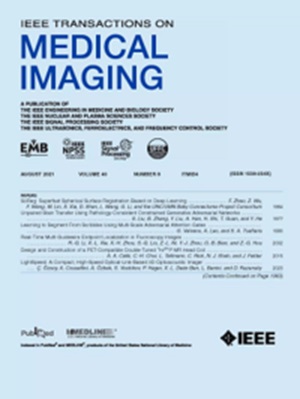A Method for Electrical Property Tomography Based on a Three-Dimensional Integral Representation of the Electric Field
IF 8.9
1区 医学
Q1 COMPUTER SCIENCE, INTERDISCIPLINARY APPLICATIONS
引用次数: 3
Abstract
Magnetic resonance electrical properties tomography (MREPT) noninvasively reconstructs high-resolution electrical property (EP) maps using MRI scanners and is useful for diagnosing cancerous tissues. However, conventional MREPT methods have limitations: sensitivity to noise in the numerical Laplacian operation, difficulty in reconstructing three-dimensional (3D) EPs and convergence not guaranteed in the iterative process. We propose a novel, iterative 3D reconstruction MREPT method without a numerical Laplacian operation. We derive an integral representation of the electric field using its Helmholtz decomposition with Maxwell’s equations, under the assumption that the EPs are known on the boundary of the region of interest with the approximation that the unmeasurable magnetic field components are zero. Then, we solve the simultaneous equations composed of the integral representation and Ampere’s law using a convex projection algorithm whose convergence is theoretically guaranteed. The efficacy of the proposed method was validated through numerical simulations and a phantom experiment. The results showed that this method is effective in reconstructing 3D EPs and is robust to noise. It was also shown that our proposed method with the unmeasurable component $H^{-}$ enhances the accuracy of the EPs in a background and that with all the components of the magnetic field reduces the artifacts at the center of the slices except when all the components of the electric field are close to zero.一种基于电场三维积分表示的电特性层析成像方法
磁共振电特性断层扫描(MREPT)使用MRI扫描仪无创重建高分辨率电特性(EP)图,可用于诊断癌组织。然而,传统的MREPT方法有局限性:数值拉普拉斯运算中对噪声的敏感性、重建三维(3D)EP的困难以及迭代过程中不能保证收敛性。我们提出了一种新的迭代三维重建MREPT方法,无需数值拉普拉斯运算。我们使用亥姆霍兹分解和麦克斯韦方程组推导了电场的积分表示,假设EP在感兴趣区域的边界上是已知的,并且不可测量的磁场分量近似为零。然后,我们使用凸投影算法来求解由积分表示和安培定律组成的联立方程,该算法的收敛性在理论上是有保证的。通过数值模拟和体模实验验证了该方法的有效性。结果表明,该方法在重建三维EP时是有效的,并且对噪声具有较强的鲁棒性。还表明,我们提出的具有不可测量分量$H^{-}$的方法提高了背景下EP的精度,并且具有磁场的所有分量的方法减少了切片中心的伪影,除非电场的所有分量都接近零。
本文章由计算机程序翻译,如有差异,请以英文原文为准。
求助全文
约1分钟内获得全文
求助全文
来源期刊

IEEE Transactions on Medical Imaging
医学-成像科学与照相技术
CiteScore
21.80
自引率
5.70%
发文量
637
审稿时长
5.6 months
期刊介绍:
The IEEE Transactions on Medical Imaging (T-MI) is a journal that welcomes the submission of manuscripts focusing on various aspects of medical imaging. The journal encourages the exploration of body structure, morphology, and function through different imaging techniques, including ultrasound, X-rays, magnetic resonance, radionuclides, microwaves, and optical methods. It also promotes contributions related to cell and molecular imaging, as well as all forms of microscopy.
T-MI publishes original research papers that cover a wide range of topics, including but not limited to novel acquisition techniques, medical image processing and analysis, visualization and performance, pattern recognition, machine learning, and other related methods. The journal particularly encourages highly technical studies that offer new perspectives. By emphasizing the unification of medicine, biology, and imaging, T-MI seeks to bridge the gap between instrumentation, hardware, software, mathematics, physics, biology, and medicine by introducing new analysis methods.
While the journal welcomes strong application papers that describe novel methods, it directs papers that focus solely on important applications using medically adopted or well-established methods without significant innovation in methodology to other journals. T-MI is indexed in Pubmed® and Medline®, which are products of the United States National Library of Medicine.
 求助内容:
求助内容: 应助结果提醒方式:
应助结果提醒方式:


